Customizing Your First Phoenix Page
A New Page
In this chapter we’re going to add our first custom Route — an Info page — giving us practice in the basics of html we learned last time, as well as our first look at a more full cycle of a request in Phoenix.
Here’s what it will look like at the end of this chapter:
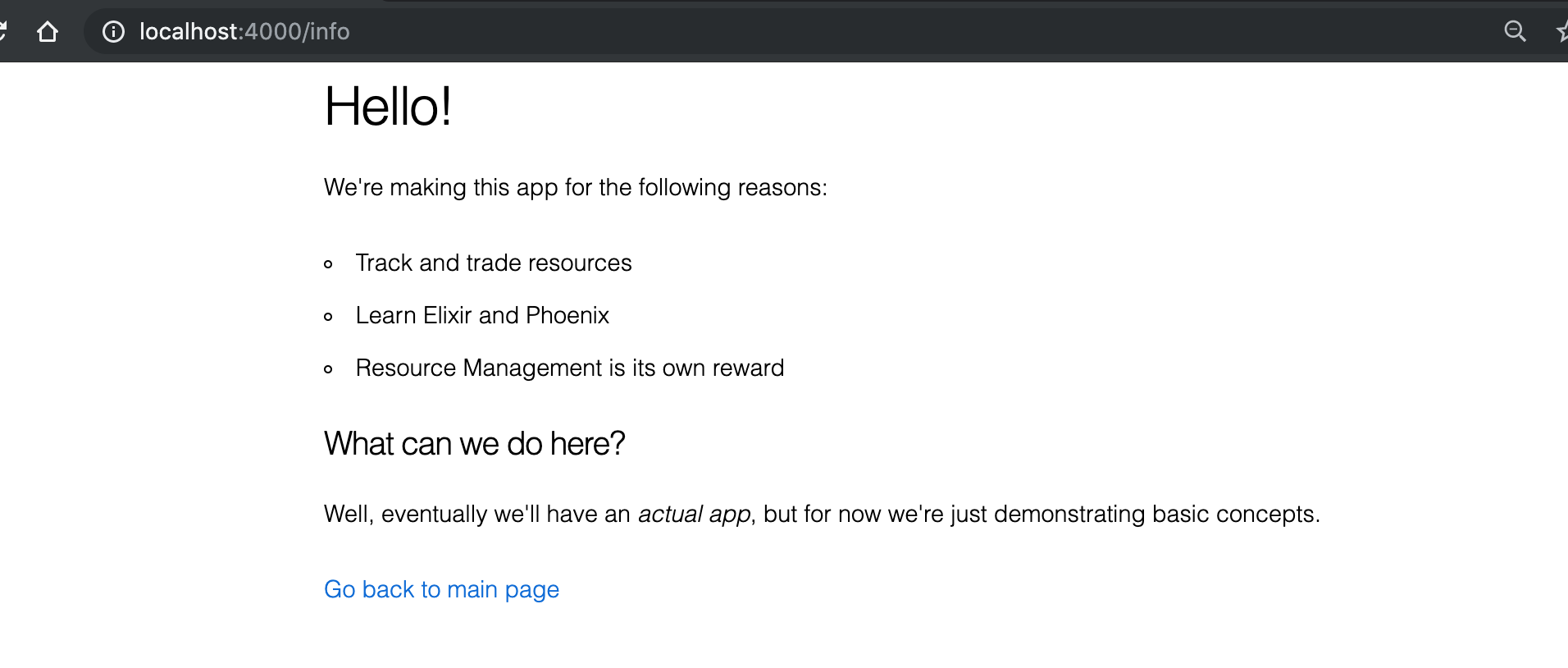
But this is what it would look like right now if you tried to visit localhost:4000/info:
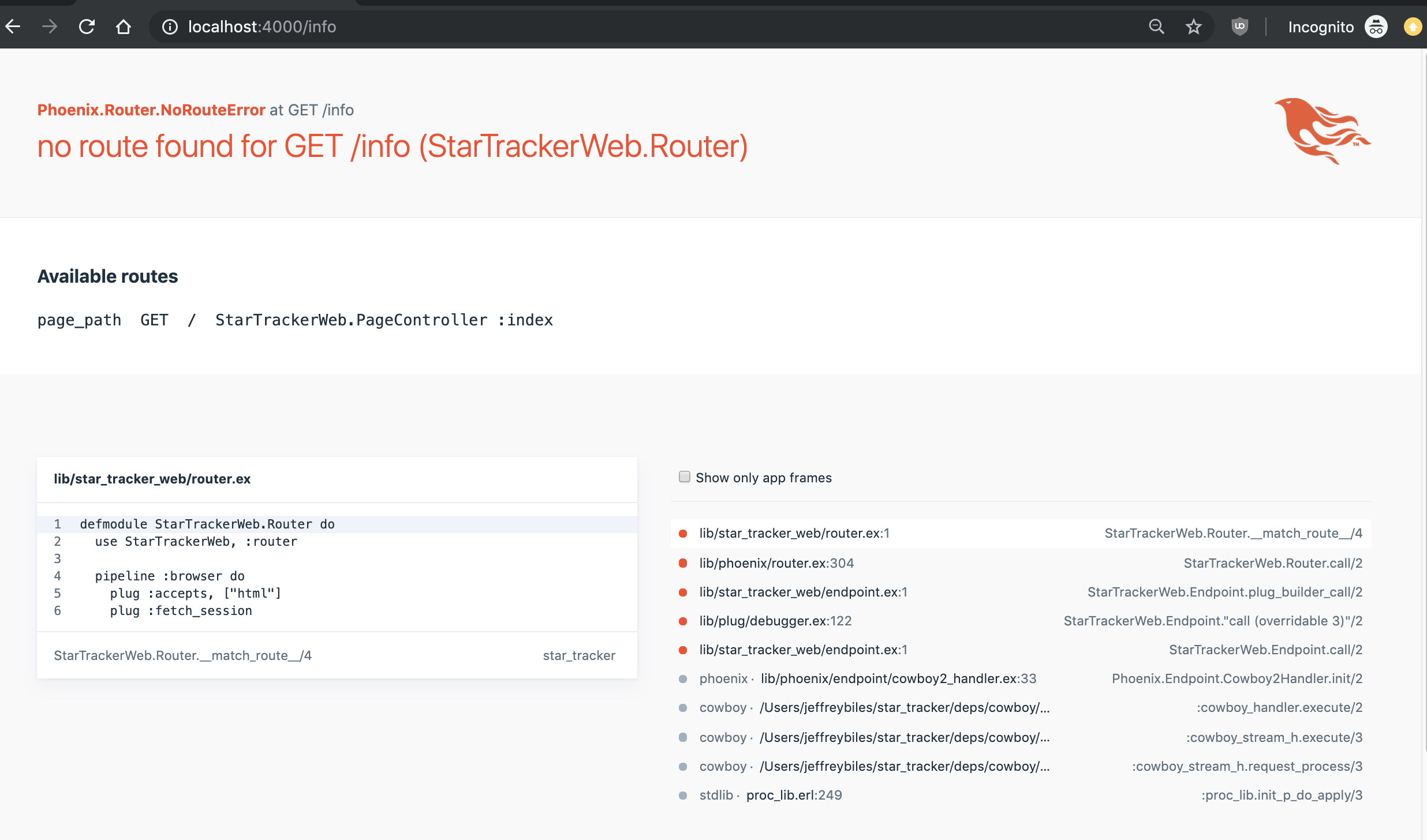
The error message is “no route found for GET /info (StarTrackerWeb.Router)”.
The Router
Let’s crack open our Router file, in lib/star_tracker_web/router.ex, and start exploring. It should look like this:
defmodule StarTrackerWeb.Router do
use StarTrackerWeb, :router
pipeline :browser do
plug :accepts, ["html"]
plug :fetch_session
plug :fetch_flash
plug :protect_from_forgery
plug :put_secure_browser_headers
end
pipeline :api do
plug :accepts, ["json"]
end
scope "/", StarTrackerWeb do
pipe_through :browser
get "/", PageController, :index
end
# Other scopes may use custom stacks.
# scope "/api", StarTrackerWeb do
# pipe_through :api
# end
endWe’ll go over this line by line before making our edit.
The Router Name
First, notice the module name: StarTrackerWeb.Router. Many many module names in our app will start with StarTrackerWeb- it’s a good indication that what we’re using is local to our Phoenix app. Then the second part- Router tells us the specific usage of this module.
Both parts of the name are very important, and Phoenix will freak out if you change either one. Try it! Change it to StarTrackerWeb.Diverter or something and Phoenix will immediately start asking where StarTrackerWeb.Router went.
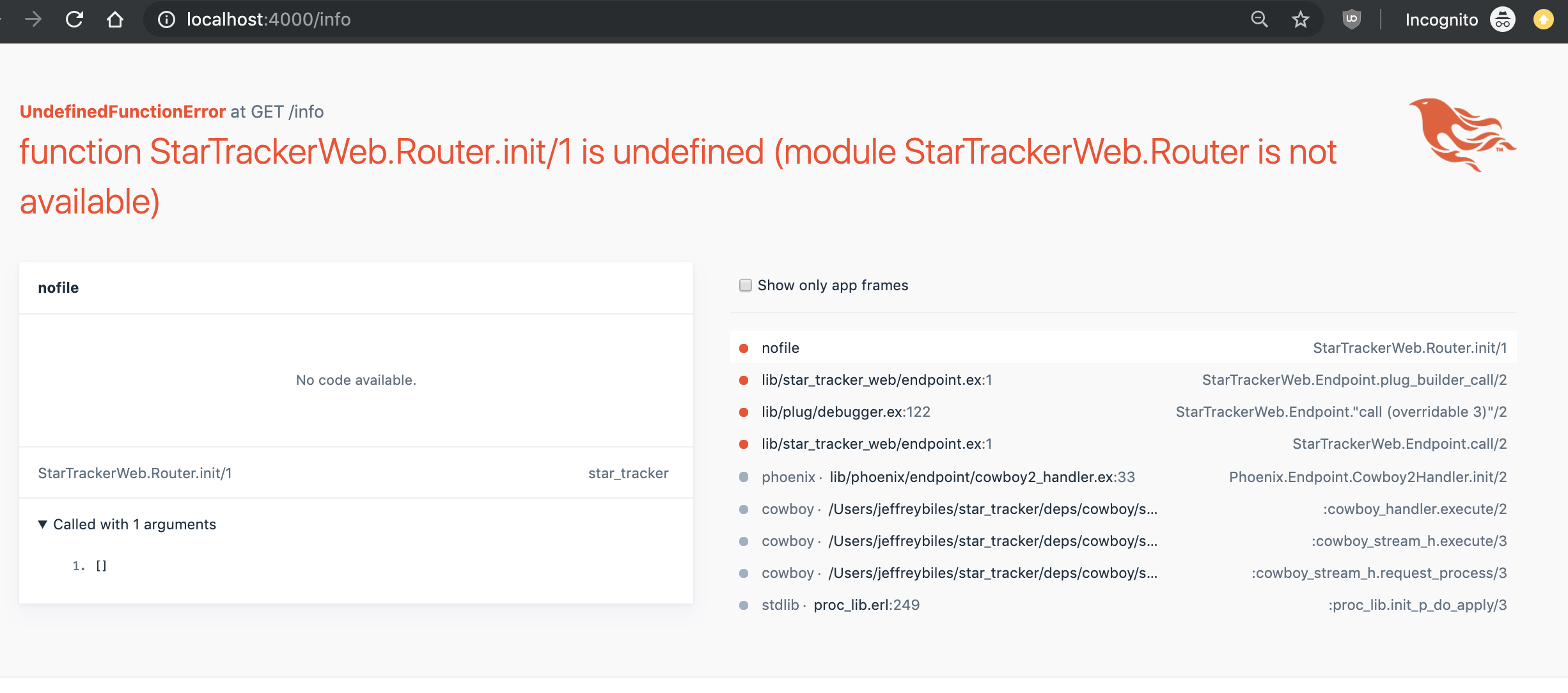
If you start getting messages like that (“Module StarTrackerWeb.X is not available”) the most probably cause is that you misnamed something.
Let’s change it back and then move on.
Macros
The next line is use StarTrackerWeb, :router. We’ll go into detail in the next chapter on how that works, but for now just know that that’s how we get the pipeline, plug, scope, pipe_through, and get macros used later in the file.
Technobabble: Macros
Macros are a cool advanced Elixir feature that give us more power and syntactical freedom than regular functions and let us define a DSL (Domain Specific Language).
While we won’t be defining our own Macros in this book, we’ll be taking advantage of lots of them that are built into Phoenix- the items from
StarTracker.Web, :routerare just the first.
If you’re an advanced coder, I’d encourage you to research Macros for yourself. A good resource for this is Metaprogramming Elixir by Chris McCord (the creator of the Phoenix framework). It’s a short but advanced book- if you had any trouble with chapters 2.2-2.4, I recommend waiting until the end of this book, and possibly reading a more detailed Intro to Elixir book first.
The first of those macros is pipeline. We define two of them: browser and api. Each has a series of plugs — a set of stacked instructions to run on each request (we’ll go over plugs later in the book) — that provide helpful functionality for the specific type of request we’re running.
The Routes Themselves
Next we see the following:
scope "/", StarTrackerWeb do
pipe_through :browser # Use the default browser stack
get "/", PageController, :index
endThe scope macro takes two arguments and a block.
The first argument is the base url- / here, so effectively nil- and the second argument is the app that will serve in this scope- StarTrackerWeb. Everything else in the scope will be prefixed with that (for example, PageController will actually be StarTrackerWeb.PageController). The block is everything between do and end, and where we use pipe_through and get.
pipe_through :browser says that within this scope, we’ll be using the browser pipeline that was defined earlier in the file.
get takes 3 arguments- the url, the controller, and the function. Here the url is /, the controller is PageController, and the function is :index. What this means is that if a GET request is sent to the url /, then we’ll respond with the index function on PageController.
Previously on: Request Types
GET is only one of several types of requests available. It’s the most common, but other common types include POST, PUT, and DELETE.
Generally GET is used when you want information from the server but aren’t requesting that the server make any changes.
We’ll cover the other request types later when we start using them.
Our New Route
Let’s define our own route now- info. It’ll be a get request, since we don’t need the server to make any changes. We’ll want the url to be /info, we can re-use the PageController, and we’ll call our function :info.
scope "/", StarTrackerWeb do
pipe_through :browser # Use the default browser stack
get "/", PageController, :index
get "/info", PageController, :info
endNow if we try to visit /info, we’ll get a different error!
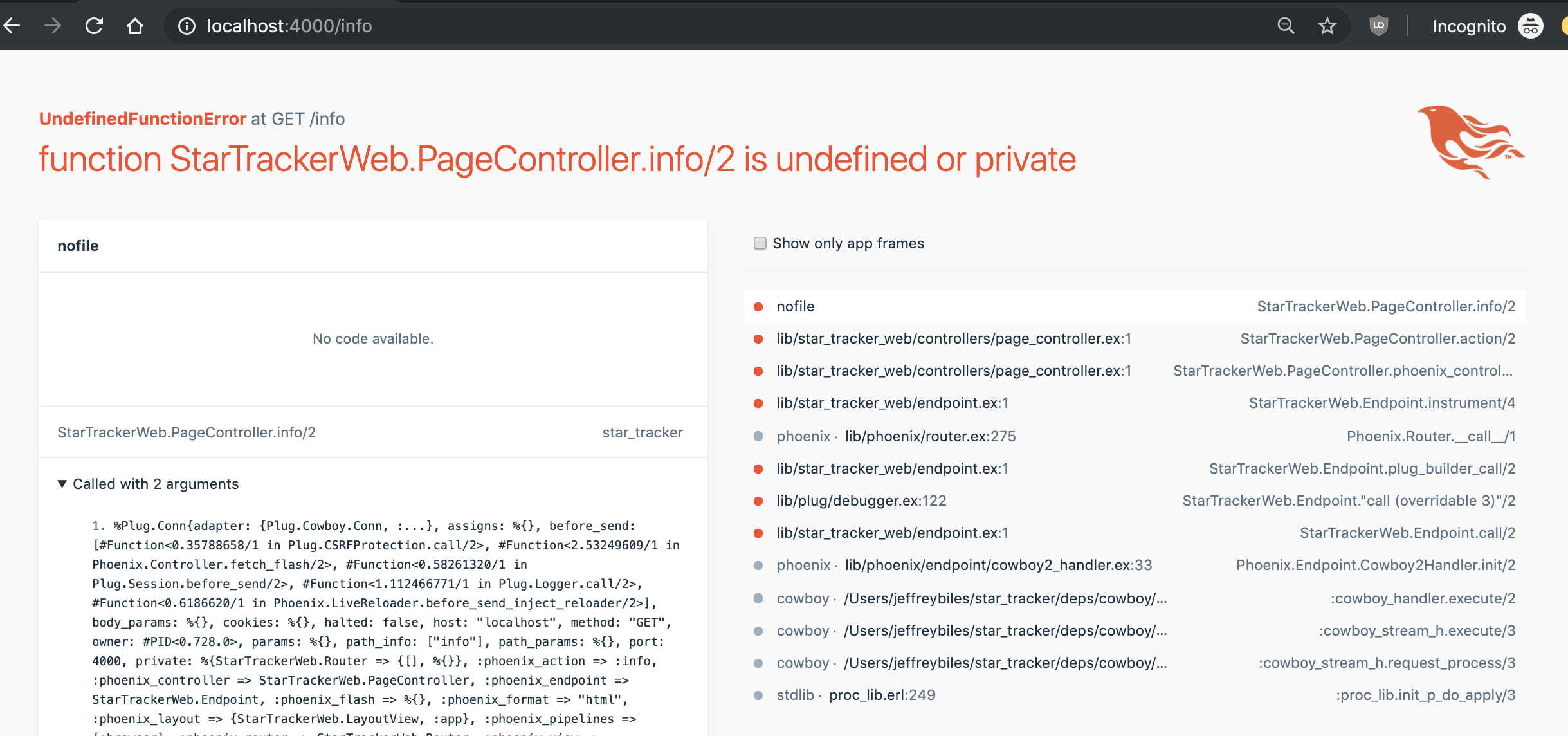
It says “function StarTrackerWeb.PageController.info/2 is undefined or private”. Time to define it!
The Controller
First, let’s look at our current code for PageController:
defmodule StarTrackerWeb.PageController do
use StarTrackerWeb, :controller
def index(conn, _params) do
render conn, "index.html"
end
endThe defmodule is StarTrackerWeb.PageController- the naming of which is, once again, is very important. Try changing the name if you don’t believe me.
Don’t Change the Name
Even if you also change the name in the get function, it will still complain. Let’s change it in both places to PageTroller (both in the Controller defmodule and in the get function for :index) and see what happens.
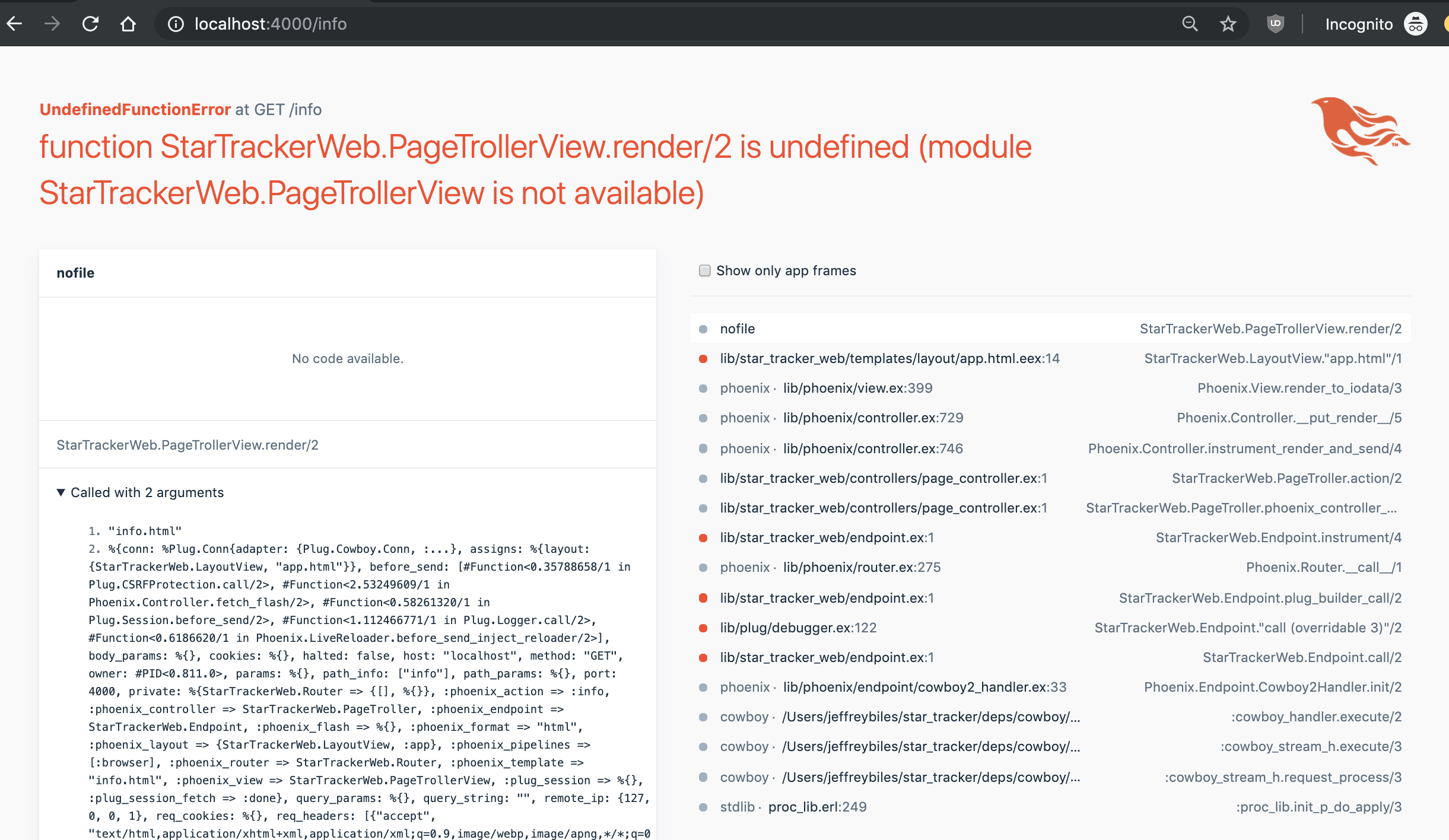
The error is “function StarTrackerWeb.PageTrollerView.render/2 is undefined (module StarTracker.PageTrollerView is not available)”. It’s looking for a StarTrackerWeb.PageTrollerView module that doesn’t exist. If we really wanted to change the name, we’d have to go change two more things: the view and the name of a templates folder.
But we don’t want to change the names, so go ahead and change them back if you messed around with them. There’s rarely a good reason to stray from the conventions that Phoenix recommends.
Our Current Controller Function
We’ll once again skip over the line with use (use StarTrackerWeb, :controller), leaving it to the next chapter, and move on to our index function.
def index(conn, _params) do
render conn, "index.html"
endEach Phoenix Controller function takes two arguments: connection and parameters (conn and _params in this example). We’ll go over the connection in more detail in later chapters, but right now we just need it to feed to the render function. _params, on the other hand, is not needed. Starting an argument name with _ is a great way to signal to future readers of your code that you don’t intend to use it, while still being more descriptive than just a plain _. If we decided to use that argument, we would change it to params.
We then use the render function and feed it two arguments: the connection and then a string, "index.html". The string indicates where we’ll get the template to display our page. This is partly Phoenix Magic; through naming conventions it knows that index.html in the PageController means lib/star_tracker_web/templates/page/index.html.eex, and it also knows to use the StarTrackerWeb.PageView as the View (we’ll cover Views later).
Our New Controller Function
Our controller function won’t be too much different.
defmodule StarTrackerWeb.PageController do
use StarTrackerWeb, :controller
def index(conn, _params) do
render conn, "index.html"
end
def info(conn, _params) do
render conn, "info.html"
end
endAs you can see, the only differences are the name and the location of the template file. This is enough to give us a new error message when we try to visit /info in the browser.
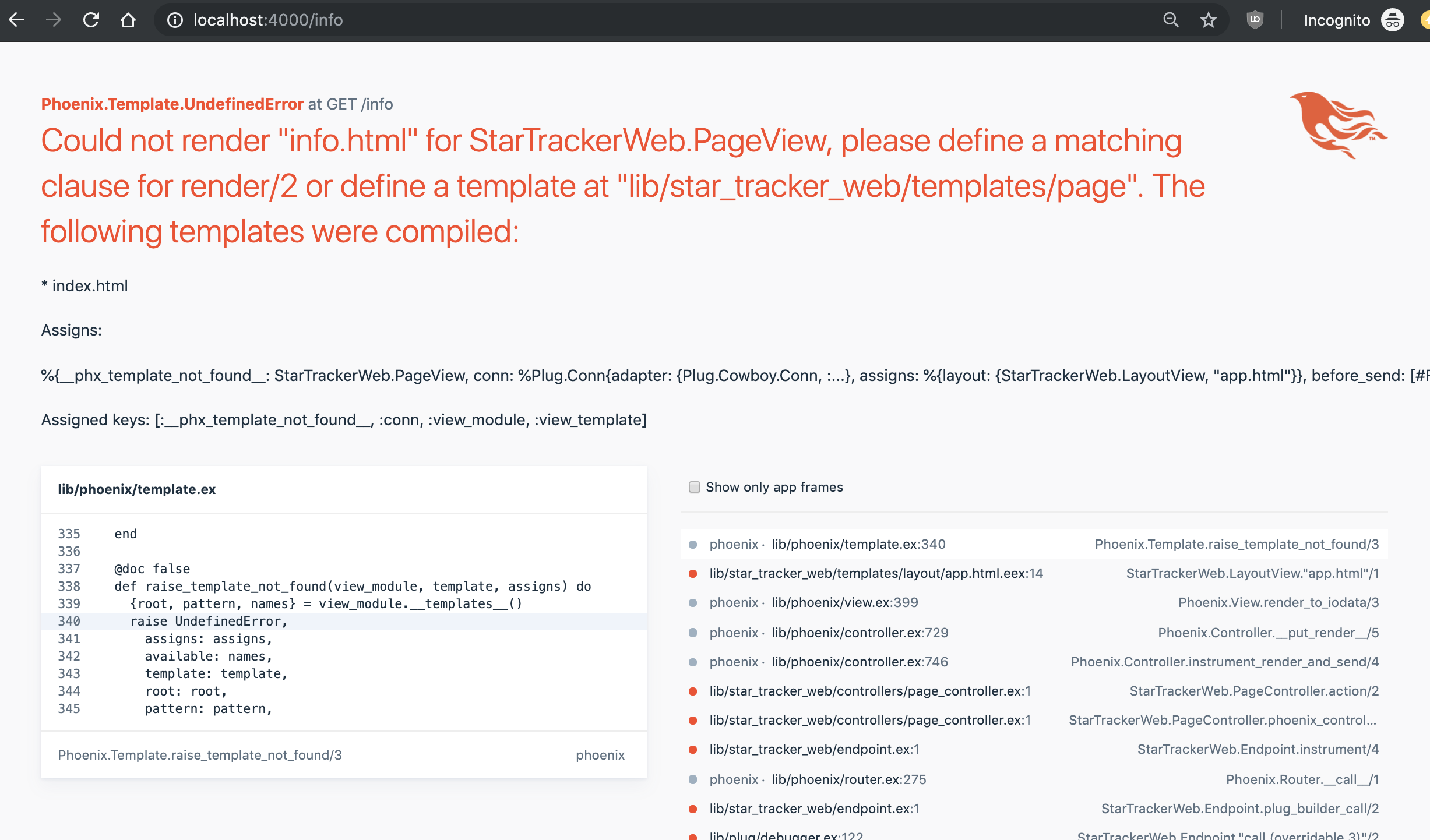
The error is “Could not render “info.html” for StarTrackerWeb.PageView, please define a matching clause for render/2 or define a template at “lib/star_tracker_web/templates/page””. It’s pretty clear what we need to do: define a template.
The Template
If we simply create a file at lib/star_tracker_web/templates/page/info.html.eex we’ll see an immediate change: no more error, just a blank page:
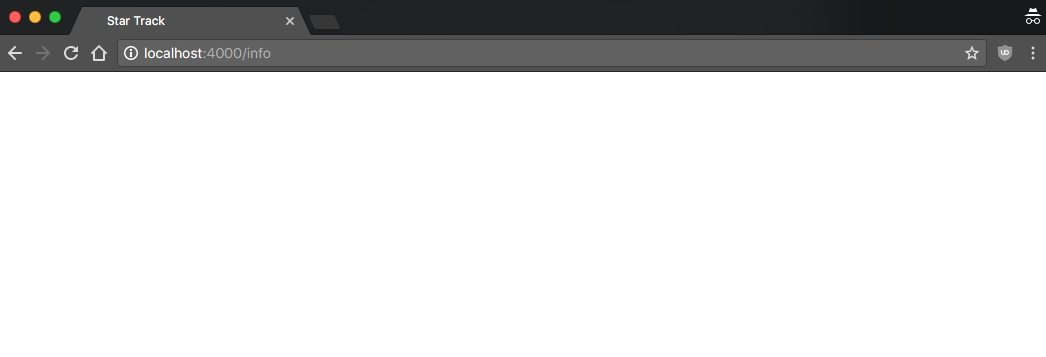
We can do better than that though- we can put words on the page!
<h1>Hello!</h1>
<p>We're making this app for the following reasons:</p>
<ul>
<li>Track and trade resources</li>
<li>Learn Elixir and Phoenix</li>
<li>Resource Management is its own reward</li>
</ul>
<h3>What can we do here?</h3>
<p>Well, eventually we'll have an <em>actual app</em>, but for now we're just demonstrating basic concepts.</p>
<a href="/"><div class="btn btn-primary">Go back to main page</div></a>This is all plain html, but it gets the job of filling out our page done.

Previously On: HTML
We’re introducing some new HTML elements/tags here.
First is the ul/li combo. “ul” stands for “unordered list”, and “li” stands for “list item”. You’ll see several “li”s nested within one “ul”. The default styling is a bullet pointed list, although you can change that.
“h3” is like “h2”, but smaller. “h1” through “h6” are available, with “h1” being the biggest and “h6” the smallest.
“em” stands for “emphasis”. By default this does the same thing as italics (<i>).
“a” stands for “anchor”. It’s a link. We won’t often use the bare “a” tag in Phoenix — we’ll prefer the
linkhelper we’ll introduce in chapter 2.6 — but this html is good enough to get our page working.
And with that, we have our page!
Exercises
- Bring your local app up to where we are.
- There are many places where naming is important to Phoenix, but other places where it isn’t. Try changing naming in the following two places:
a) The Controller function name: try changing
:infoto:aboutin thegethelper in the Router, and then change the function name in the Controller toaboutas well. b) The template name: changeinfo.htmltoinformation.htmlin the Controller function, then change the template filename to match (web/templates/page/information.html.eex).
You’ll know you’ve succeeded once you’ve made the changes and the page at /info still works as before. If you want to check that it’s actually doing something and not just coasting off an old version of the app, feel free to check halfway through each change- when you’ve changed one of the parts but not the other. You should, at that point, see an error message.
Conclusion
In this chapter we’ve create a new page at the url /info. To do this we had to create a new Route in the Router, a new function in the Controller, and a new template. Although we’ll expand on it later, Route -> Controller -> Template is the basic path that all requests take when being served by Phoenix.
In the next chapter, we’ll explore further the connections between the Router, the Controller, and the Template.
Curious where all of those handy macros come from, like
getorpipeline? Check out the appendix section where we explainuse,import, andalias.
Buy the Ebook